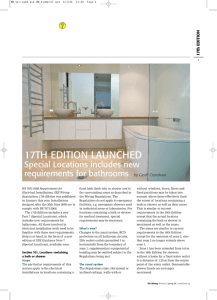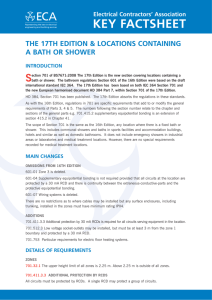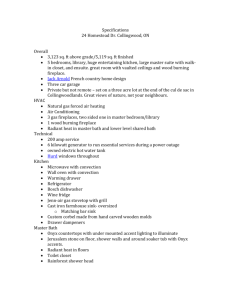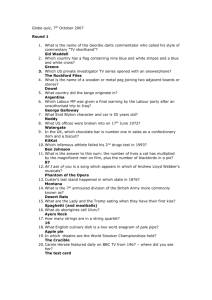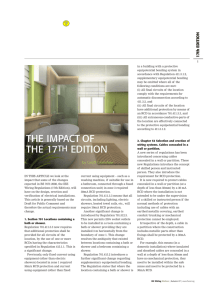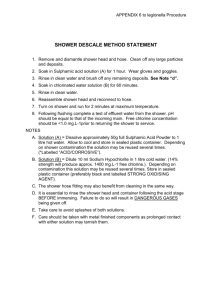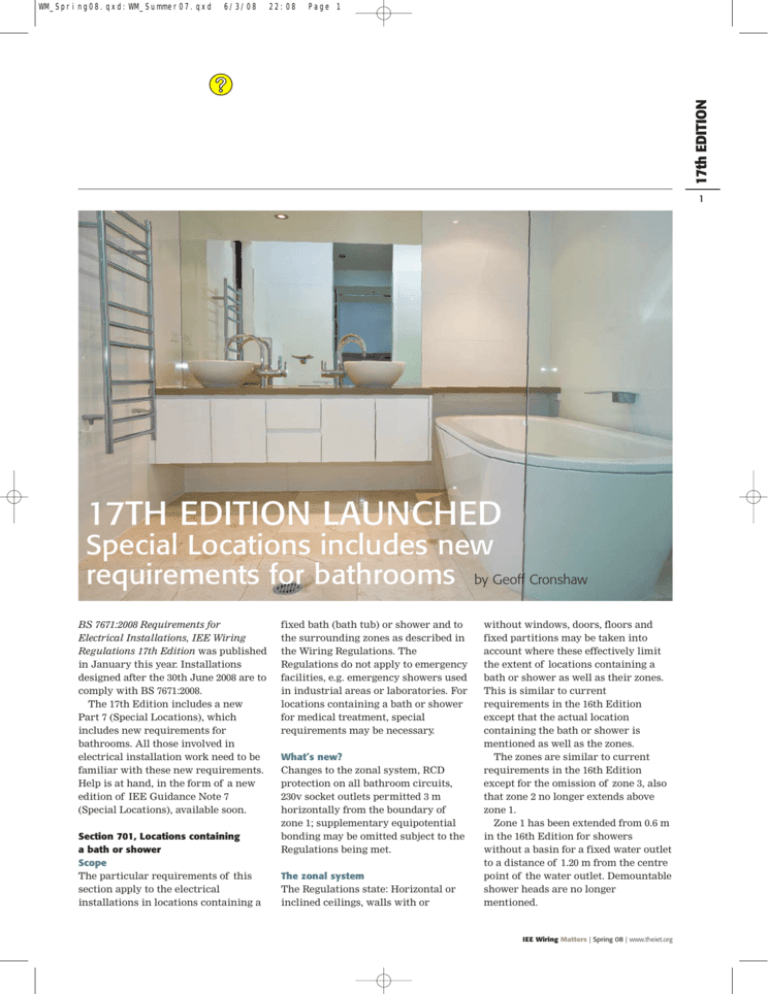
6/3/08
22:08
Page 1
17th EDITION
WM_Spring08.qxd:WM_Summer07.qxd
1
17TH EDITION LAUNCHED
Special Locations includes new
requirements for bathrooms by Geoff Cronshaw
BS 7671:2008 Requirements for
Electrical Installations, IEE Wiring
Regulations 17th Edition was published
in January this year. Installations
designed after the 30th June 2008 are to
comply with BS 7671:2008.
The 17th Edition includes a new
Part 7 (Special Locations), which
includes new requirements for
bathrooms. All those involved in
electrical installation work need to be
familiar with these new requirements.
Help is at hand, in the form of a new
edition of IEE Guidance Note 7
(Special Locations), available soon.
Section 701, Locations containing
a bath or shower
Scope
The particular requirements of this
section apply to the electrical
installations in locations containing a
fixed bath (bath tub) or shower and to
the surrounding zones as described in
the Wiring Regulations. The
Regulations do not apply to emergency
facilities, e.g. emergency showers used
in industrial areas or laboratories. For
locations containing a bath or shower
for medical treatment, special
requirements may be necessary.
What’s new?
Changes to the zonal system, RCD
protection on all bathroom circuits,
230v socket outlets permitted 3 m
horizontally from the boundary of
zone 1; supplementary equipotential
bonding may be omitted subject to the
Regulations being met.
The zonal system
The Regulations state: Horizontal or
inclined ceilings, walls with or
without windows, doors, floors and
fixed partitions may be taken into
account where these effectively limit
the extent of locations containing a
bath or shower as well as their zones.
This is similar to current
requirements in the 16th Edition
except that the actual location
containing the bath or shower is
mentioned as well as the zones.
The zones are similar to current
requirements in the 16th Edition
except for the omission of zone 3, also
that zone 2 no longer extends above
zone 1.
Zone 1 has been extended from 0.6 m
in the 16th Edition for showers
without a basin for a fixed water outlet
to a distance of 1.20 m from the centre
point of the water outlet. Demountable
shower heads are no longer
mentioned.
IEE Wiring Matters | Spring 08 | www.theiet.org
6/3/08
22:09
Page 2
17th EDITION
WM_Spring08.qxd:WM_Summer07.qxd
2
Ceiling
zone 2
Outside zones
Window
recess
zone 2
zone 1
Window
recess
zone 2
Outside zones
zone 2
2.25 m
zone 0
zone 0
0.60 m
*
Window recess
0.60 m
zone 2
Figure 1: Zone dimensions elevation view showing a bath tub
Zone 1 is now limited by the
horizontal plane corresponding to the
highest fixed shower head or water
outlet or the horizontal plane lying
2.25 m above the finished floor level,
whichever is higher.
RCD Protection
Regulation 701.411.3.3 now requires
that additional protection shall be
provided for all circuits of the location
by the use of one or more RCDs having
the characteristics specified in
Regulation 415.1.1. This is a significant
change. Previously (601-09-02), only
fixed current using equipment (other
than electric showers) located in zone
1 required 30mA RCD protection and
current using equipment (other than
Figure 2: Zone dimensions fixed current using equipment – such plan view showing a bath tub
as a washing machine, if suitable for
use in a bathroom, connected through
a fused connection unit) in zone 3
required 30mA RCD protection.
Fixed water outlet
Regulation 701.411.3.3 means that all
1.20 m
circuits, including lighting, electric
showers, heated towel rails, etc.,
will require RCD protection, not
zone 1
zone 0
exceeding 30 mA.
230 volt socket-outlets
Another significant change is
introduced by Regulation 701.512.3.
This now permits 230v socket-outlets
Figure 3: Zone dimensions - plan view
showing a shower without a basin
Wiring Matters is produced by IET Services Limited, a subsidiary of The Institution of Engineering and Technology (IET), for the IET.
Michael Faraday House, Six Hills Way, Stevenage, Herts, SG1 2AY, United Kingdom Tel: +44 (0)1438 313311 Fax: +44 (0)1438 313465
Advertising Sales D Smith +44 (0)1438 767224 daniellesmith@theiet.org | Editor G D Cronshaw +44 (0)1438 767384
gcronshaw@theiet.org | Contributing Editors M Coles, J Elliott, J Ware | Design Sable Media Solutions
IEE Wiring Matters is a quarterly publication from the Institution of Engineering and Technology (IET). The IET is not as a body responsible for
the opinions expressed.
©2008: The Institution of Engineering and Technology. All rights reserved. No part of this publication may be reproduced, stored in a retrieval
system, or transmitted in any form or by any means without the permission in writing of the publisher. Copying of articles is not permitted
except for personal and internal use. Multiple copying of the content of this publication without permission is always illegal. Web-offset
printing by Wyndeham Heron, The Bentall Complex, Colchester Road, Heybridge, Maldon, Essex, UK
Co-operating Organisations The Institution of Engineering & Technology acknowledges the contribution made by the following
organisations in the preparation of this publication: British Electrotechnical & Allied Manufacturers Association Ltd – R Lewington,
P D Galbraith, M H Mullins | Department for Communities and Local Government – I Drummond | Electrical Contractors Association – D Locke,
S Burchell | City & Guilds of London Institute – H R Lovegrove | Energy Networks Association – D J Start | Electrical Contractors Association
of Scotland SELECT – D Millar, N McGuiness | Health & Safety Executive – K Morton | Electrical Safety Council | ERA Technology Limited –
M Coates | British Cables Association – C Reed | Scottish Building Standards Agency | DTI – D Tee | CORGI – P Collins | GAMBICA –
M. Hadley, A. Sedhev.
ISSN 1749-978-X
IEE Wiring Matters | Spring 08 | www.theiet.org
WRRFP81
6/3/08
23:08
Page 4
17th EDITION
WM_Spring08.qxd:WM_Summer07.qxd
4
to be installed in a room containing a
bath or shower providing they are
installed 3 m horizontally from the
boundary of zone 1. This change
resolves the ambiguity that existed
between locations containing a bath or
shower and a bedroom containing a
shower.
Supplementary equipotential bonding
Regulation 701.415.2 introduces a
further significant change regarding
supplementary equipotential bonding.
The Regulation states that where the
location containing a bath or shower
is in a building with a protective
equipotential bonding system in
accordance with Regulation 411.3.1.2,
supplementary equipotential
bonding may be omitted where
all of the following conditions
are met:
(i) All final circuits of the location
comply with the requirements for
automatic disconnection according to
411.3.2, and
(ii) All final circuits of the location
have additional protection by means of
an RCD in accordance 701.411.3.3, and
(iii) All extraneous-conductive-parts of
the location are effectively connected
to the protective equipotential bonding
according to 411.3.1.2.
This means the designer needs to
make an assessment that all
extraneous-conductive-parts of the
location are effectively connected to
the protective equipotential bonding
according to 411.3.1.2.
NOTE: The effectiveness of the
connection of extraneous-conductiveparts in the location to the main
earthing terminal may be assessed,
where necessary, by the application of
Regulation 415.2.2.
Regulation 415.2.2 states: Where
doubt exists regarding the
effectiveness of supplementary
equipotential bonding, it shall be
confirmed that the resistance R
between simultaneously accessible
exposed-conductive-parts and
extraneous conductive-parts fulfils the
IEE Wiring Matters | Spring 08 | www.theiet.org
following condition:
R ≤ 50 V/Ia in a.c. systems
R ≤ 120 V/Ia in d.c. systems
where
Ia is the operating current in amperes
of the protective device for RCDs, IΔn,
for overcurrent devices, the current
causing automatic operation in 5 s.
External influences
The Regulations state:
Electrical equipment exposed to water
jets, e.g. for cleaning purposes, shall
have a degree of protection of at least
IPX5. The Regulations no longer limit
the IPX5 requirement to communal
baths or communal showers.
There are no particular ingress
protection requirements beyond
zone 2. This means that BS 1363
accessories, such as switches and
fused connection units, can be
installed beyond zone 2, subject to the
requirements of Regulation 512.2
(external influences).
Current-using equipment
The 16th Edition made a clear division
between equipment permitted to be
installed in zone 1 and equipment
permitted to be installed in zone 2. In
the 17th Edition no requirements are
stated for zone 2. This is because all
circuits of the location now require
RCD protection.
The term “current-using equipment
other than fixed current-using
equipment” no longer appears in the
17th Edition.
Current-using equipment, such as
washing machines and tumble dryers
for example, continue to be allowed to
be installed beyond zone 2, subject to
manufacturers’ approval similar to the
16th Edition. Such equipment must
be supplied by means of a fused
connection unit within 3 m
horizontally from the boundary of
zone 1. Beyond 3 m they may be
supplied by means of a plug and
socket-outlet.
Shaver supply units
The minimum degree of protection for
equipment installed in zones 1 and 2 is
IPX4 or IPX5 where water jets are
likely to be used for cleaning purposes.
An exception to this requirement is a
shaver supply unit complying with
BS EN 60742 Chapter 2, Section 1,
which, although it does not meet the
requirements of IP4X, is permitted in
zone 2 but must be located where
direct spray from showers is unlikely.
This type of shaver supply unit, which
incorporates a safety isolating
transformer, is the only type which is
permitted in a bathroom or shower
room.
More information.
For more information please refer to
the 17th Edition of the Wiring
Regulations. Also, help is at hand, in
the form of a new edition of IEE
Guidance Note 7 (Special Locations)
available soon.

